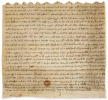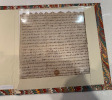A COOKERY MANUSCRIPT: 1718-9.
Cookery Recipes in a fine light cursive hand.
Octavo -180 x 119 mm. 1fep. 62. 3 pages of Courses. 1 page Index. 1fep. Full manuscript text in a light cursive script. Contemporary sheep boards with faint blind panel tooling and a nice patina. Re-backed spine with raised bands, compartments ruled in gilt, red calf label. A handsome item with Lord Westbury' s bookplate and the owner, Dorcas Thornycroft's signature on the front pastedown.
- One of only a handful of known manuscripts from the cookery school of Edward Kidder. Circa- 1665/7-1739. Perhaps the best-known cookery teacher active in early 18th-century London, this is a precursor to Kidder's first published collection, 'Receipts of Pastry and Cookery' circa.1720. (see items 10966 and 11290 in this collection). This manuscript contains most recipes that appeared in Kidder's published 'Receipts', as well as several unpublished. With the ownership inscription of a landed lady and enticing marks of use, this offers a rare window into Kidder's teaching practice. Kidder ran classes in pastry-making from as early as 1702 until at least 1734 at various premises, including Holborn and Lincoln's Inn Field. Kidder's school was one of the earliest of its kind in England and he professed to have taught some 6,000 ladies in his time. 'Receipts' was republished five times before 1740 and such was its popularity that multiple authors, including Mary Kettilby, Robert Smith, John Nott, Charles Carter, and Sarah Harrison, plagiarised it. A valuable record of over 150 interpretations of standard English dishes from this period, the manuscript follows the chapter divisions of 'Receipts', and includes several recipes or variants which do not appear in the published version. A few of these appeared in print later in 1723, plagiarised by Robert Smith. Manuscript recipe books compiled in an instructional context are very rarely seen in commerce: miscellaneous or personal compilations are more common. Six other manuscript versions of Kidder's published book of 'Receipts', with slight variations, are held institutionally; two of them bear manuscript dates (University of Leeds: 1702; UCLA: 1721-22). Multiple examples are uniformly bound in panelled calf as here, written following the same structure and paginated with an index. Some have printed title pages, listing different locations for Kidder's school and indicating that ladies were taught in their own houses. We have traced only one other example at auction, over 50 years ago. How these manuscripts were compiled is debated. Although one theory suggests that Kidder provided blank notebooks to his students, who then copied the recipes, the Manuscript Cookbook Survey posits that as "the hands of these books are neat and uniform, it seems unlikely that students copied Kidder's recipes piecemeal while attending Kidder's classes. It seems more plausible that the copying was done at a desk, with the printed book at hand, in a series of closely spaced sittings" (MCS). If Kidder's students were mostly household cooks sent by their employers, it is also unlikely that they "produced these books, for the hands. appear to be practiced and confident, those of well-educated persons. It is more plausible that the copiers were those 'ladies' whom Kidder 'taught in their own houses'" (MCS). As the handwriting does not always match the ownership inscriptions (as here), and as many examples are executed in a near-identical hand, some manuscripts were possibly professionally transcribed by copyists for distribution before Kidder gathered sufficient funds for a printed publication. This explanation particularly applies to the manuscripts, including the present example, with hand-written dates before 1720. The contents and date of the UCLA manuscript indicate that it was produced between the second and third printed edition (Varey, p. 48 PPC), showing that Kidder may have maintained a manuscript tradition of "textbooks" even after the printed publication. This manuscript belonged to Dorcas Thornycroft, circa 1690-1759, and has her ownership inscriptions and date of "1718-9, March ye (the) 23" on the front pastedown. Thornycroft was the owner of Sharsted Court, a manor house in Newnham, Kent, and heiress to Gideon Delaune, apothecary to Anne of Denmark, wife of King James I. She was unmarried and lived in the house with her sister until her death. Thornycroft seems to fall in the category of well-educated women who were taught by Kidder at home. The manuscript is in a flowing and easily readable hand, and the occasional stains, particularly in the section dedicated to fish, at pp. 46-51, suggest that she used it frequently. Some of the recipe titles find parallels in a 1699 manuscript cookery and medical recipe book which is held in the Wellcome Collection (MS.3107) and is inscribed "Edward and Katherine Kidder". The attribution is still unconfirmed but the similarities with this example are undeniable. In some cases, the recipe instructions are similar (such as for "Scotch Collops"), while in other cases there are methodological variations, such as the process for pickling cucumbers and mushrooms, or in the recipe for Gingerbread Cakes. Only one of the unpublished recipes in the present manuscript also appears in the Wellcome manuscript, that for green pea soup. Offering insights into the manuscript and publishing tradition of 18th-century cookery teaching, Provenance: Richard Bethell, 4th Baron Westbury (1914-1961), who owned an extensive collection of rare culinary works, with his bookplate on the front pastedown; his sale, Sotheby's, February 1965, lot 311. Westbury wrote the much-referenced Handlist of Italian Cookery Books (1963) and co-authored With Gusto and Relish (1957). ~"Some notes on Edward Kidder", PPC, vol. 65, 2000; Peter Targett, "Edward Kidder: his book and his schools", PPC, vol. 32, 1989; Simon Varey, "New light on Edward Kidder's Receipts", PPC, vol. 39, 1991.





click on image to enlarge

Antiquarian category
ref number:
11050